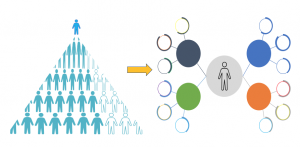Teams are at the core of successful work in organizations. Very few things can be accomplished by individuals. There is increasing talk about teams. Inspiring work has been done in military environments, as illustrated through the book Team of Teams by General Stanley McChrystal.
But what is a team? How do you choose the members, and how can they work together as smoothly as possible to achieve the best results?
Cross-functional work
In conventional hierarchies people are positioned in company functions and report to their functional head. However, none of these functions is isolated. In order to achieve bottom line results there has to be collaboration among all the functions. So everyday there are increasing initiatives aimed at promoting “teamwork,” often driven by the HR department. At leadership C-suite level, this can translates into the CEO having to harmonize the agendas of function heads.
The fact is that the artificial divisiveness that companies tend to impose is unnecessary, unwieldy and out of synch with how we now understand reality. The elements of a network, their interactions, the common goal they pursue and the context within which they exist do not have to be dealt with in isolation. There is an alternative. It’s not just a hunch or a trend. We have been publishing based on the results of a new solution since 1999. A science of leadership exists and there are fewer and fewer reasons to ignore it.
There is a way out of the blind alley of organizational divisiveness that stems from artificial silos. It begins with understanding that company functions can be seen in a very different way to create more fluidity and involvement. They can be perceived as a repository of competencies or subject matter expertise. In other words, they contain the know-how needed in order to achieve the tasks at hand.
These tasks, no matter how difficult or complex, require some form of interdependence with other sets of competencies; accordingly, organizational design only makes sense when it concentrates on creating the best, easiest and smoothest way to allow these competencies to interact.
Interact for what? To achieve a common goal; invariably, this goal is connected with satisfying the Market. Only when we truly understand what an organization is can we design one. Organizations are whole systems. Organizational design, then, is the science, not the magic, of enabling different competencies to achieve the goals for which they have been brought together.
Teams based on competencies
In order to carry out the projects certain competencies are needed and so we need teams based on competencies. Isn’t this just a cross-functional team? No. Because in a network of projects we synchronize people’s efforts by scheduling them on a project based on their competency. All of the work of the organization can be carried out in this way, from accounting to New Product Development. In this way, the same person may be contributing to various projects across the whole system simultaneously.
Only a portion of people’s time is scheduled
So to be truly effective towards a goal, a team is not just a group of people. A team is made up of people with the specific competencies required for a specific project or projects and those competencies are synchronized through accurate scheduling. Accurate scheduling means based on real availability and for this we can use Critical Chain.
For this scheduling to happen in a realistic and practical way, only part of any one person’s time is scheduled. To schedule more than 60% or even 50% of a person’s time on specific activities would be counter-productive. People need unscheduled time to do their work and that includes having breaks, conversations and thinking and planning.
Teamwork is indeed something that organizations need to foster instead of ranking individuals. For a systemic point of view, it is quite inappropriate to reward individuals for results when no single person can achieve results on their own. It is the design of the system, as Deming repeatedly told us, that influences how results are achieved and no matter how hard people try, their efforts will always be shaped by the system. This does not mean that self-fulfillment is not possible. When an organization works well as a whole system, when it prioritizes people’s best talents and abilities, it is inevitably a more satisfying workplace because it is designed and managed so that people can contribute to the overall goal through their unique capabilities.
Sign up to our blog here and shift your thinking towards broader, systemic possibilities for yourself and your organization. Intelligent Management provides education and training on systemic management, W. Edwards Deming’s management philosophy and the Theory of Constraints (Decalogue methodology) in North America and Europe.
About the Author
Angela Montgomery Ph.D. is Partner and Co-founder of Intelligent Management and author of the business novel+ website The Human Constraint , so far purchased in 22 countries around the globe. This downloadable novel uses narrative to look at how the Deming approach and the Theory of Constraints can create the organization of the future, based on collaboration, network and social innovation. She is co-author with Dr. Domenico Lepore, founder, and Dr. Giovanni Siepe of ‘Quality, Involvement, Flow: The Systemic Organization’ from CRC Press, New York.






Leave a Reply